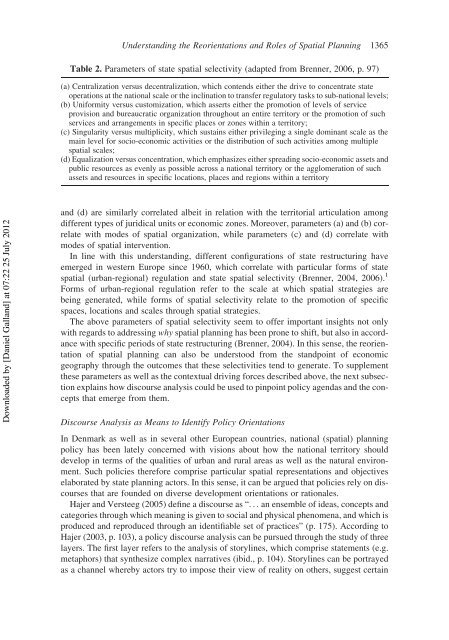Galland EPS 2012 - VBN
Galland EPS 2012 - VBN
Galland EPS 2012 - VBN
Create successful ePaper yourself
Turn your PDF publications into a flip-book with our unique Google optimized e-Paper software.
Understanding the Reorientations and Roles of Spatial Planning 1365<br />
Table 2. Parameters of state spatial selectivity (adapted from Brenner, 2006, p. 97)<br />
(a) Centralization versus decentralization, which contends either the drive to concentrate state<br />
operations at the national scale or the inclination to transfer regulatory tasks to sub-national levels;<br />
(b) Uniformity versus customization, which asserts either the promotion of levels of service<br />
provision and bureaucratic organization throughout an entire territory or the promotion of such<br />
services and arrangements in specific places or zones within a territory;<br />
(c) Singularity versus multiplicity, which sustains either privileging a single dominant scale as the<br />
main level for socio-economic activities or the distribution of such activities among multiple<br />
spatial scales;<br />
(d) Equalization versus concentration, which emphasizes either spreading socio-economic assets and<br />
public resources as evenly as possible across a national territory or the agglomeration of such<br />
assets and resources in specific locations, places and regions within a territory<br />
Downloaded by [Daniel <strong>Galland</strong>] at 07:22 25 July <strong>2012</strong><br />
and (d) are similarly correlated albeit in relation with the territorial articulation among<br />
different types of juridical units or economic zones. Moreover, parameters (a) and (b) correlate<br />
with modes of spatial organization, while parameters (c) and (d) correlate with<br />
modes of spatial intervention.<br />
In line with this understanding, different configurations of state restructuring have<br />
emerged in western Europe since 1960, which correlate with particular forms of state<br />
spatial (urban-regional) regulation and state spatial selectivity (Brenner, 2004, 2006). 1<br />
Forms of urban-regional regulation refer to the scale at which spatial strategies are<br />
being generated, while forms of spatial selectivity relate to the promotion of specific<br />
spaces, locations and scales through spatial strategies.<br />
The above parameters of spatial selectivity seem to offer important insights not only<br />
with regards to addressing why spatial planning has been prone to shift, but also in accordance<br />
with specific periods of state restructuring (Brenner, 2004). In this sense, the reorientation<br />
of spatial planning can also be understood from the standpoint of economic<br />
geography through the outcomes that these selectivities tend to generate. To supplement<br />
these parameters as well as the contextual driving forces described above, the next subsection<br />
explains how discourse analysis could be used to pinpoint policy agendas and the concepts<br />
that emerge from them.<br />
Discourse Analysis as Means to Identify Policy Orientations<br />
In Denmark as well as in several other European countries, national (spatial) planning<br />
policy has been lately concerned with visions about how the national territory should<br />
develop in terms of the qualities of urban and rural areas as well as the natural environment.<br />
Such policies therefore comprise particular spatial representations and objectives<br />
elaborated by state planning actors. In this sense, it can be argued that policies rely on discourses<br />
that are founded on diverse development orientations or rationales.<br />
Hajer and Versteeg (2005) define a discourse as “...an ensemble of ideas, concepts and<br />
categories through which meaning is given to social and physical phenomena, and which is<br />
produced and reproduced through an identifiable set of practices” (p. 175). According to<br />
Hajer (2003, p. 103), a policy discourse analysis can be pursued through the study of three<br />
layers. The first layer refers to the analysis of storylines, which comprise statements (e.g.<br />
metaphors) that synthesize complex narratives (ibid., p. 104). Storylines can be portrayed<br />
as a channel whereby actors try to impose their view of reality on others, suggest certain
















